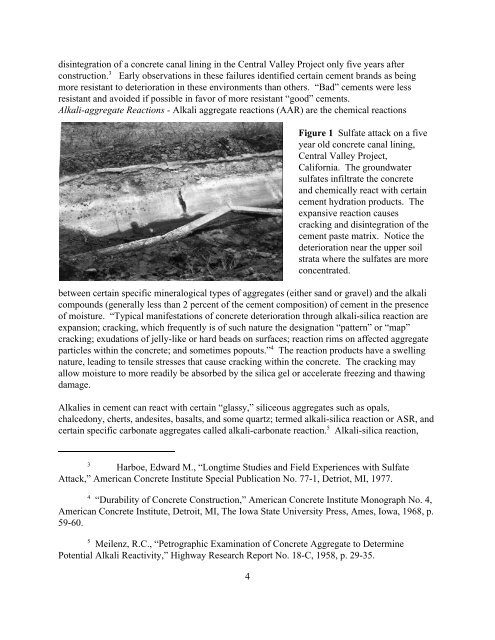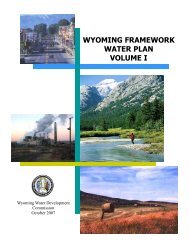Dolen, Timothy P. - - Historical Development of Durable Concrete for ...
Dolen, Timothy P. - - Historical Development of Durable Concrete for ...
Dolen, Timothy P. - - Historical Development of Durable Concrete for ...
Create successful ePaper yourself
Turn your PDF publications into a flip-book with our unique Google optimized e-Paper software.
disintegration <strong>of</strong> a concrete canal lining in the Central Valley Project only five years after<br />
construction. 3 Early observations in these failures identified certain cement brands as being<br />
more resistant to deterioration in these environments than others. “Bad” cements were less<br />
resistant and avoided if possible in favor <strong>of</strong> more resistant “good” cements.<br />
Alkali-aggregate Reactions - Alkali aggregate reactions (AAR) are the chemical reactions<br />
Figure 1 Sulfate attack on a five<br />
year old concrete canal lining,<br />
Central Valley Project,<br />
Cali<strong>for</strong>nia. The groundwater<br />
sulfates infiltrate the concrete<br />
and chemically react with certain<br />
cement hydration products. The<br />
expansive reaction causes<br />
cracking and disintegration <strong>of</strong> the<br />
cement paste matrix. Notice the<br />
deterioration near the upper soil<br />
strata where the sulfates are more<br />
concentrated.<br />
between certain specific mineralogical types <strong>of</strong> aggregates (either sand or gravel) and the alkali<br />
compounds (generally less than 2 percent <strong>of</strong> the cement composition) <strong>of</strong> cement in the presence<br />
<strong>of</strong> moisture. “Typical manifestations <strong>of</strong> concrete deterioration through alkali-silica reaction are<br />
expansion; cracking, which frequently is <strong>of</strong> such nature the designation “pattern” or “map”<br />
cracking; exudations <strong>of</strong> jelly-like or hard beads on surfaces; reaction rims on affected aggregate<br />
particles within the concrete; and sometimes popouts.” 4 The reaction products have a swelling<br />
nature, leading to tensile stresses that cause cracking within the concrete. The cracking may<br />
allow moisture to more readily be absorbed by the silica gel or accelerate freezing and thawing<br />
damage.<br />
Alkalies in cement can react with certain “glassy,” siliceous aggregates such as opals,<br />
chalcedony, cherts, andesites, basalts, and some quartz; termed alkali-silica reaction or ASR, and<br />
certain specific carbonate aggregates called alkali-carbonate reaction. 5 Alkali-silica reaction,<br />
3<br />
Harboe, Edward M., “Longtime Studies and Field Experiences with Sulfate<br />
Attack,” American <strong>Concrete</strong> Institute Special Publication No. 77-1, Detriot, MI, 1977.<br />
4 “Durability <strong>of</strong> <strong>Concrete</strong> Construction,” American <strong>Concrete</strong> Institute Monograph No. 4,<br />
American <strong>Concrete</strong> Institute, Detroit, MI, The Iowa State University Press, Ames, Iowa, 1968, p.<br />
59-60.<br />
5<br />
Meilenz, R.C., “Petrographic Examination <strong>of</strong> <strong>Concrete</strong> Aggregate to Determine<br />
Potential Alkali Reactivity,” Highway Research Report No. 18-C, 1958, p. 29-35.<br />
4

















